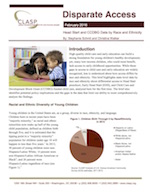 A new report from the Center for Law and Social Policy (CLASP) in Washington, D.C., finds wide racial disparities in access to government programs aimed to help children who are born into poverty. The report highlights state-level data by race and ethnicity about differential access to Head Start preschool, Early Head Start (EHS), and Child Care and Development Block Grant (CCDBG)-funded child care.
A new report from the Center for Law and Social Policy (CLASP) in Washington, D.C., finds wide racial disparities in access to government programs aimed to help children who are born into poverty. The report highlights state-level data by race and ethnicity about differential access to Head Start preschool, Early Head Start (EHS), and Child Care and Development Block Grant (CCDBG)-funded child care.
The report finds that a whopping 24 percent of young American children were living in poverty. For young Black children, the poverty rate was 43 percent.
The report found that nationwide only 43 percent of eligible children participated in the Head Start preschool program. Only 46 percent of eligible Black children participated in Head Start. There were huge discrepancies between the states. Mississippi, Kansas, and Michigan all had Head Start participation rates of 67 percent or higher. In Arizona, only 28 percent of eligible students participated in Head Start. In Texas, Colorado, and Nevada, participation rates were 35 percent or lower.
In Pennsylvania, 42 percent of eligible Black parents received Child Care and Development Block Grant (CCDBG)-funded child care. This was the highest rate in the nation. In Wisconsin, Oklahoma, Florida, Indiana, Kansas, and Maryland only 8 percent of eligible Black parents received these child care grants. Nationwide, 21 percent of Black children eligible to be given government-funded child care, actually are covered under the CCDBG program.
The full report, Disparate Access: HeadStart and CCDBG Data by Race and Ethnicity, may be downloaded by clicking here.











